Your browser does not fully support modern features. Please upgrade for a smoother experience.
Please note this is an old version of this entry, which may differ significantly from the current revision.
There is no human nutrition without crop production, which itself must be supported by proper and sufficient plant nutrients. These plant nutrients can play a crucial role in sustainably promoting agricultural production on cultivated lands, facilitating soil carbon sequestration, and taking pressure off global peatlands and forests
- plant
- Sustainable Agriculture
- climate change
- salinity
- drought
- biofortified crop
- nutrients
- degraded soil
- plant secondary metabolites
- elevated CO2
1. Introduction
The agroecosystem includes soil, cultivated plants, and other compartments [1]. This system has basic ecological and nutritional functions for human health, including fluxes of nutrients and energy and their interactions among different species, which control global food production [1]. The world’s population is expected to exceed 10 billion by 2050, and the world’s food production needs to increase more and more [2]. This food production is primarily dependent on crop productivity, and it is primarily controlled by the molecular–physiological functions of plant mineral nutrients and their deficiency [3]. Plant-derived nutrients are crucial for human nutrition and maintenance of human health [4]. There is no human nutrition without crop production, which itself must be supported by proper and sufficient plant nutrients [5]. These plant nutrients can play a crucial role in sustainably promoting agricultural production on cultivated lands, facilitating soil carbon sequestration, and taking pressure off global peatlands and forests [6]. Recently, several studies have reported on plant nutrition and its impact on human health, with topics such as the role of plants in human health with a focus on greening biotechnology [7], responsible plant nutrition [8], and the relationship between plant nutrition and food security under climate change [9]. It is also worth mentioning recent studies on the potential of aromatic, rare, and endemic wild species found in extensively controlled agroecosystems that have never used by humans [10][11], including crop wild relatives [12].
2. Plant Nutrition and Sustainable Agriculture
Plant nutrition deals with nutrient uptake, intravascular motility, nutrients’ roles in plant growth and development, and the physiological and biochemical functions of nutrients in plants. This science also includes the main methods for applying fertilizers or nutrients, the relationship between plant nutrition and human health as expressed in phytomedicine, and management of different cases of plant nutrients, particularly under environmental stresses in in vivo (Figure 1A,B) or in vitro studies (Figure 2). There are many methods that can be used to carry out studies on plant nutrition, including in vivo (in the field, greenhouses, pots, etc.) and in vitro (in the lab) methods, and they may use soilless culture, hydroponics, or micro-farm systems. These methods have different classifications, such as controlled and noncontrolled experiments [13][14], in vitro and in vivo studies, and quotative and qualitative studies [15].
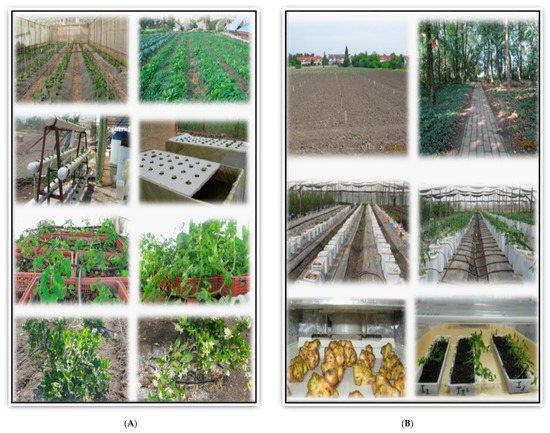
Figure 1. (A) Some photos of in vivo studies for plant nutrition investigations. The upper photos are from open field and greenhouse (the upper photos of cucumber and lettuce) and different hydroponic systems (the 4 middle photos of lettuce and tomato), whereas the lower photos (citrus plants) represent the soil application of mineral (super phosphate) and organic fertilizers (organic manure). These agricultural systems are found in the experimental farm at Kafrelsheikh University. (B) More studies on plant nutrition could be investigated within open field (the upper photo left), forest (the upper photo right), and greenhouse using different growing systems (the middle photos), whereas the lower photos represent the micro-farm system using growing media or without growing media. All photos by El-Ramady.
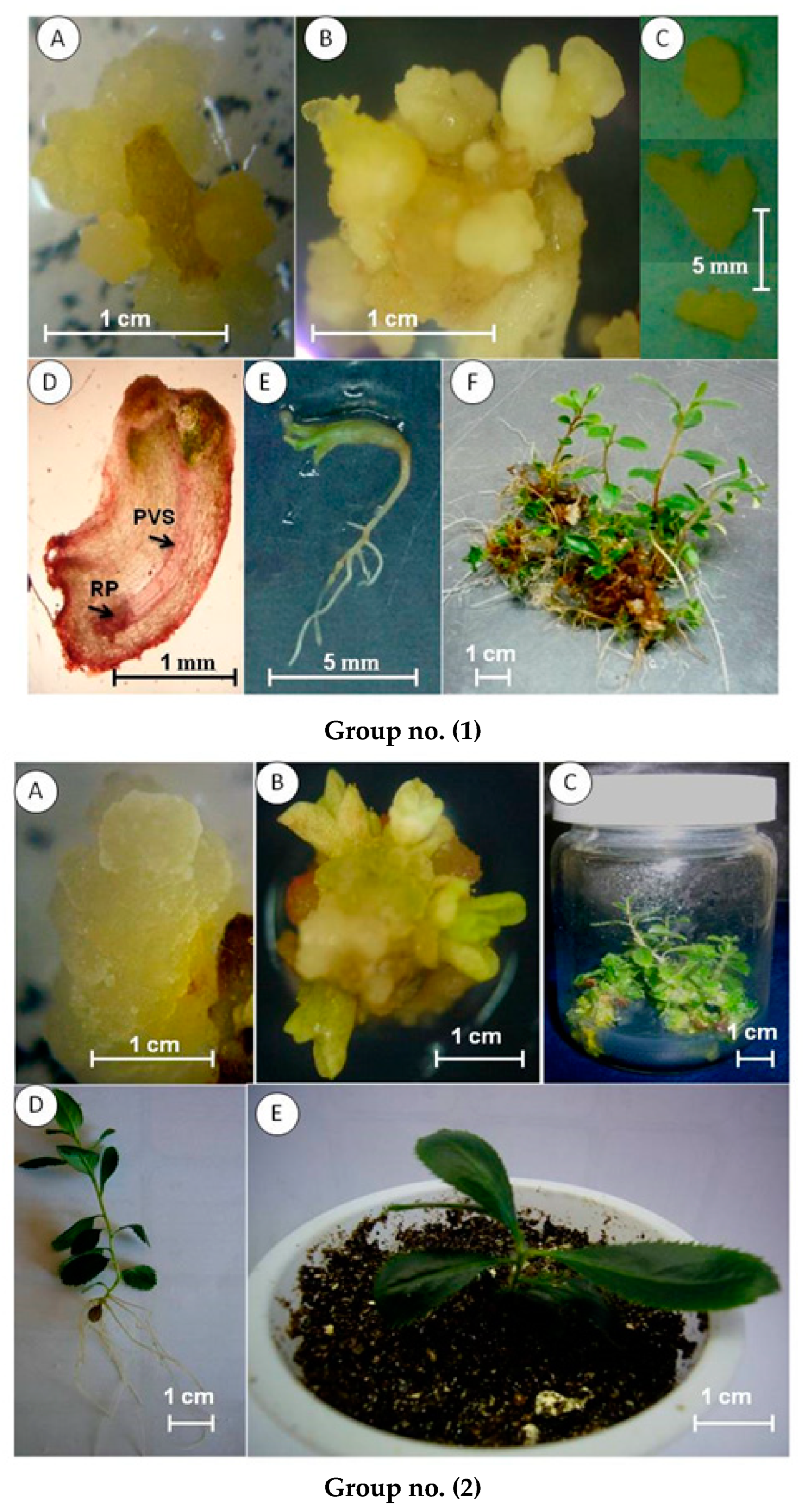
Figure 2. A case study for plants in vitro as a promising tool for plant nutrition. Group (1): Somatic embryogenesis of strawberry tree (Arbutus unedo L.), where photos (A,B) are of embryogenic callus; (C) different stages of embryo (globular, heart, and torpedo); (D) torpedo stage of embryo; (E) cotyledonary stage of embryo; (F) plantlets initiated from somatic embryos. Group (2): Indirect propagation of strawberry tree, where photo (A) is of callus induction; (B) callus differentiation; (C) shoot formed from callus; (D) shoot rooted; (E) acclimatized plants. All photos by El-Mahrouk.
The world’s population is constantly increasing. Therefore, food security in the 21st century is a serious concern [5]. A total of 17 Sustainable Development Goals (SDGs) were adopted as part of a new 15-year sustainable development strategy. Ending hunger, achieving food security and improving nutrition, and promoting sustainable agriculture are among the 17 aims. The four most relevant time-sensitive goals are as follows:
- By 2030, ending hunger;
- By 2030, ending all malnutrition forms;
- By 2030, doubling agricultural productivity;
- By 2030, ensuring sustainable food production systems [16].
Agriculture confronts several obstacles worldwide, making it extremely difficult to meet its primary goal of supplying food and nutrition security to an increasing population [17][18]. Figure 3A,B presents some essential obstacles that face agriculture and farming livelihoods. These obstacles affect the energy for agro-practices, animal farming, intercropping, irrigation and drainage water and their efficacy, wastes from agriculture and domestic life, and seedlings and their preparing. Poor soil fertility, low levels of available mineral nutrients in the soil, improper nutrient management, and a lack of vegetation genotypes with higher tolerance to nutrient deficiency or toxicity are currently main limitations associated with food insecurity, malnourishment (i.e., micronutrient deficiencies), and ecological degradation in many developing countries [5]. Research in plant nutrition removes these restrictions and, as a result, provides important knowledge that is extremely beneficial in ensuring sustainable food security and well-being for humans without harming the environment [5]. To achieve the desired crop yield, chemical fertilizers are overused [19]; however, chemical fertilizers have been used for centuries and have greatly enhanced agricultural yields [20]. The overuse of chemical fertilizers has resulted in soil, environmental, and aquatic pollution, particularly soil mineral imbalances, degraded soil structure and soil fertility, soil quality deterioration, eutrophication, and ground water and air pollution, all of which are severe long-term barriers. Furthermore, the uncontrolled use of chemical fertilizers boosts production costs while decreasing farmer profit. To keep intensive agriculture productive while decreasing negative environmental consequences, systematic measures to restore natural resources are essential [19][20]. It has also been observed that traditional agricultural techniques are related to excessive usage of agrochemicals. As a result, the agricultural sector requires modification in order to achieve self-sufficiency in food production and provide healthy and safe food in the face of climate change difficulties. One such solution that solves agricultural problems may be the practice of sustainable agriculture [18].
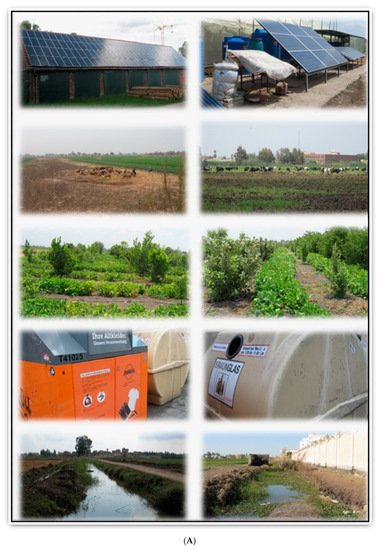
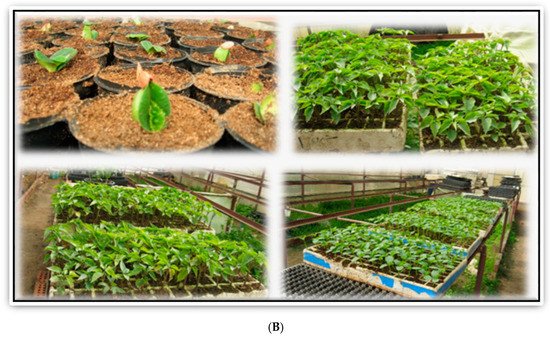
Figure 3. (A) Some creative technologies that boost agricultural output while protecting environmental quality, which may include saving the required energy for different agricultural practices (the upper photos), saving proper and sufficient feeds of farm animals (the 3rd and 4th photos), intercropping using horticultural crops (the 5th and 6th photos), domestic wastes and their sorting/collecting in certain containers (the 7th and 8th photos of horticultural plants), and irrigation canals and drainers and their efficiency (the 9th and 10th photos). All previous agro-practices need to be sustained. All photos by El-Ramady. (B) The production of seedlings in agricultural nurseries is very important, using different materials for growing media to supply the agriculture in field or greenhouse with healthy seedlings. All previous agro-practices need to be sustained. All photos of horticultural seedlings (such as pepper and tomato) by El-Ramady.
Bioenergy or biorefinery crops are mainly the plants that are compatible with sustainable agriculture such as Jerusalem artichoke (Helianthus tuberosus L.), alfalfa (Medicago sativa L.), fruits, vegetables, grains, and other food and fiber crops [21]. These several plants and their biodiversity can promote sustainable agriculture [22]. Especially in the context of plant nutrition and agricultural sustainability, to address the dilemma of chemical fertilizer overuse, it is necessary to create smart materials that can deliver nutrients to specific places while still contributing to a clean environment. According to recent research, graphene is a promising material that might be used as a transporter for plant nutrients. It is capable of delayed and regulated nutrient release for the benefit of the plants, resulting in increased agricultural yield with minimal environmental effect [20]. Because nanoparticles have unique physicochemical properties, such as high surface area, high reactivity, their pore size distribution, and their particle shape, nanotechnology opens up a wide range of novel applications in the fields of plant nutrition required to meet the future demands of the growing population. The management of optimal nutrients for sustainable crop production is a priority topic in agricultural research. In this respect, nanonutrition has proven to be the most intriguing field of research, focusing on the provision of nano-sized nutrients for sustainable crop development [23]. These nanofertilizers and/or nano-amendments could apply to different common problematic soil cases such as saline/alkaline, waterlogged, or compacted heavy-clay-content soils, which should be managed through cultivation of the right selected crop that can be tolerant against such previously mentioned obstacles, particularly under arid and semi-arid conditions (Figure 4).
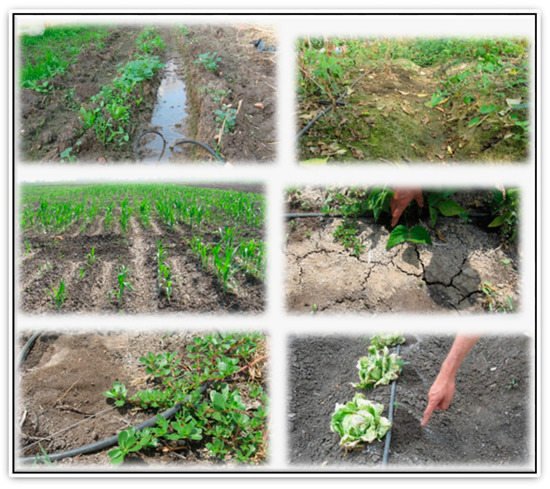
Figure 4. Cultivation in saline/alkaline, waterlogged, and compacted heavy-clay-content soil needs to manage the right crop that can be tolerant against certain obstacles, particularly under arid and semi-arid conditions. These problems include accumulation of salts on the soil surface, growing the salinity-loving grasses, waterlogged soil (the upper photos of grasses), salinity/alkalinity stress (the middle photos of maize), sodium appearance in dispersion of soil particles on the soil surface (lower photos of common purslane and lettuce), etc. All photos by El-Ramady.
Thus, agriculture may achieve sustainability by using creative technologies that boost agricultural output while protecting environmental quality. Damage to agricultural soil constitute a serious problem in developing countries, which lead to a decrease in arable lands due to urbanization and human activities, especially industrialization (Figure 5). At this point, the usage of nanohybrid constructs such as nanofertilizers (NFs) has gained prominence [19]. Nanofertilizers are nano-enabled bulk materials that are applied to increase plant nutrition. Furthermore, they have been described as next-generation fertilizers that may enable us to ensure global food security, continue improving the nutritional value of food through Fe and Zn agronomic fortification (ZnO, Fe3O4), maintain balanced nutrition to alleviate biotic and abiotic stresses, and decrease ecological footprint, resulting in lower agrochemical use and nutrient losses [24]. Nanofertilizers can also improve nutrient availability and uptake efficiency (by more than 20%) compared to conventional fertilizers, increasing plant production and nutritional value in specific crops [24]. The nanoparticles may not be stimulated quickly to be taken up by plants, but a series of processes such as oxidation and recombination may occur to give the plants the necessary micronutrients. Because the nutrients are of nanoscale size, fortifying the plant with such nanonutrients appears to be an appealing choice. Plants not only develop but also accumulate such nutrients, bridging the nutritional deficit gap. Furthermore, nanofertilizers might be designed to target specific nutritional deficiencies in plants. This is feasible because the atoms on the surfaces of nanomaterials may be arranged to have distinctively diverse characteristics [20]. In addition, NFs boost plant nutritional efficiency while, simultaneously, reducing the toxicity of chemical fertilizers. As a result, they assist developing nations, particularly in building sustainable agricultural initiatives [25]. NFs also have the following advantages: nutrient-delivered control can be interlinked to soil nutrient balance, plant growth phase, and environmental factors using nanosensors [24]. One of the environmental factors that impacts the efficiency of NP application is the agricultural system (in open field, greenhouse, pots, in vitro, etc.). Thus, plant production under greenhouse conditions is very important in addressing one of the great challenges that face developing countries, particularly those under the stress of arid and semi-arid conditions. Greenhouses have many benefits in winter as protected houses for crop production; however, due to a lack of facilities in developing countries, a range of troubles may face this production method related to soil salinization, indoor temperature and aeration, control of the soil moisture content, etc. (Figure 6).

Figure 5. Urban sprawl causes several forms of damage to agricultural soils such as building on these soils, discarding the wastes of building or construction, and collecting and storing several wastes on these soils. These photos of damage can impact agricultural production from arable lands and food security. All photos from different places in Egypt by El-Ramady.

Figure 6. Agricultural production under greenhouse conditions is very important for developed countries, especially during the period of falling snow in winter, as greenhouses are protected houses for crop production, and for developing countries, particularly under arid and semi-arid conditions, which may face a range of troubles with lack of facilities, aeration (the upper left photo), control of the soil moisture content (the middle and lower photos of cucumber and pepper), etc. All photos by El-Ramady.
In addition to using nanofertilizers for providing sufficient nutrients and avoiding many problems, many modern approaches have been adopted to achieve these targets in sustainable ways. Recently, scientists around the world have been looking at the potential function of nanoparticles in biotechnology because of their ability to transfer DNA and other substances to plant cells. In this regard, introducing C nanotubes into chloroplasts has resulted in a success for plants’ enhanced capacity to capture more light energy. Furthermore, these tubes might be used as artificial antennae for catching light wavelengths that are outside of their regular range, such as ultraviolet, green, and near-infrared [23]. DNA-based biosensors (genosensors) have recently been extensively developed for toxins detection [26]. The use of material identification to integrate nanomaterials with biosensors increases electron flow between electrodes. Electrochemical nanobiosensors have several advantages, including low cost, high sensitivity, and low identification threshold. Such sensors are extensively used in labs due to their ease of use and measurement [27]. Sensors made using nanoscience and nanomaterials have a wide range of applications in the present day. For example, using enzyme-based NSs is one of the most useful analytical techniques for finding toxins in biological materials [28]. Such approaches (i.e., nanosensors and DNA nanosensors) play a vital role in monitoring toxicity and deficiency in plant nutrients, enhancing the ability to face such challenges as limitations to plant growth and development. In this context, Podar and Maathuis [29] reported that plants evolved sophisticated systems to enhance nutrient usage efficiency, because nutrients are scarce and important resources. Monitoring external and internal nutrient levels is critical for adjusting processes including absorption, redistribution, and cellular compartmentation. Primary sensors, which often include transceptors or transcription factors, are used to measure nutrient levels. Plants’ primary receptors for some nutrients are just now being recognized. There is considerable knowledge about how members of the nitrate transporter 1 family sense the external nitrate state. Potential sensors for additional macronutrients such as potassium and salt have recently been found, while transcription-factor-type sensors for micronutrients such as zinc and iron have been described [29].
This entry is adapted from the peer-reviewed paper 10.3390/su14148329
References
- Stratton, A.E.; Kuhl, L.; Blesh, J. Ecological and Nutritional Functions of Agroecosystems as Indicators of Smallholder Resilience. Front. Sustain. Food Syst. 2020, 4, 543914.
- Goncharova, N.A.; Merzlyakova, N.V. Food Shortages and Hunger as a Global Problem. Food Sci. Technol. 2022, 42, e70621.
- Bang, T.C.; Husted, S.; Laursen, K.H.; Persson, D.P.; Schjoerring, J.K. The Molecular–Physiological Functions of Mineral Macronutrients and Their Consequences for Deficiency Symptoms in Plants. New Phytol. 2021, 229, 2446–2469.
- Roberts, D.P.; Mattoo, A.K. Sustainable Crop Production Systems and Human Nutrition. Front. Sustain. Food Syst. 2019, 3, 72.
- Cakmak, I. Plant Nutrition Research: Priorities to Meet Human Needs for Food in Sustainable Ways. Plant Soil 2002, 247, 3–24.
- Elbasiouny, H.; El-Ramady, H.; Elbehiry, F.; Rajput, V.D.; Minkina, T.; Mandzhieva, S. Plant Nutrition under Climate Change and Soil Carbon Sequestration. Sustainability 2022, 14, 914.
- Moses, T.; Goossens, A. Plants for Human Health: Greening Biotechnology and Synthetic Biology. J. Exp. Bot. 2017, 68, 4009–4011.
- Bruulsema, T.; Cakmak, I.; Dobermann, A.; Gerard, B.; Majumdar, K.; McLaughlin, M.; Reidsma, P.; Vanlauwe, B.; Wollenberg, E.K.; Zhang, F.; et al. Scientific Panel on Responsible Plant Nutrition. A New Paradigm for Plant Nutrition. Issue Brief 01. Available online: https://www.apni.net/downloads/sprpnIss01.pdf (accessed on 4 April 2022).
- Kumar, V.; Srivastava, A.; Suprasanna, P. Plant Nutrition and Food Security in the Era of Climate Change; Academic Press: Oxford, UK; Elsevier: Amsterdam, The Netherlands, 2022.
- Perrino, E.V.; Valerio, F.; Jallali, S.; Trani, A.; Mezzapesa, G.N. Ecological and Biological Properties of Satureja Cuneifolia Ten. and Thymus Spinulosus Ten.: Two Wild Officinal Species of Conservation Concern in Apulia (Italy). A Preliminary Survey. Plants 2021, 10, 1952.
- Valerio, F.; Mezzapesa, G.N.; Ghannouchi, A.; Mondelli, D.; Logrieco, A.F.; Perrino, E.V. Characterization and Antimicrobial Properties of Essential Oils from Four Wild Taxa of Lamiaceae Family Growing in Apulia. Agronomy 2021, 11, 1431.
- Perrino, E.V.; Wagensommer, R.P. Crop Wild Relatives (CWRs) Threatened and Endemic to Italy: Urgent Actions for Protection and Use. Biology 2022, 11, 193.
- Fageria, N.K. Soil Fertility and Plant Nutrition Research under Controlled Conditions: Basic Principles and Methodology. J. Plant Nutr. 2005, 28, 1975–1999.
- Fageria, N.K. Soil Fertility and Plant Nutrition Research under Field Conditions: Basic Principles and Methodology. J. Plant Nutr. 2007, 30, 203–223.
- El-Ramady, H.R.; Alshaal, T.A.; Shehata, S.A.; Domokos-Szabolcsy, É.; Elhawat, N.; Prokisch, J.; Fári, M.; Marton, L. Plant Nutrition: From Liquid Medium to Micro-Farm. In Sustainable Agriculture Reviews 14; Ozier-Lafontaine, H., Lesueur-Jannoyer, M., Eds.; Sustainable Agriculture Reviews; Springer International Publishing: Cham, Switzerland, 2014; Volume 14, pp. 449–508. ISBN 978-3-319-06015-6.
- United Nations Sustainable Development Goals. Sustainable Development Knowledge Platform. Available online: https://sustainabledevelopment.un.org/sdgs (accessed on 20 April 2022).
- Dordas, C. Role of Nutrients in Controlling Plant Diseases in Sustainable Agriculture: A Review. In Sustainable Agriculture; Lichtfouse, E., Navarrete, M., Debaeke, P., Véronique, S., Alberola, C., Eds.; Springer: Dordrecht, The Netherlands, 2009; pp. 443–460. ISBN 978-90-481-2665-1.
- Isaac, W.-A.; Felix, N.; Ganpat, W.G.; Saravanakumar, D.; Churaman, J. Sustainable Climate-Smart Agricultural Solutions to Improve Food and Nutrition Security in Trinidad and Tobago. In Development, Political, and Economic Difficulties in the Caribbean; Bissessar, A.M., Ed.; Springer International Publishing: Cham, Switzerland, 2019; pp. 167–195. ISBN 978-3-030-02993-7.
- Babu, S.; Singh, R.; Yadav, D.; Rathore, S.S.; Raj, R.; Avasthe, R.; Yadav, S.K.; Das, A.; Yadav, V.; Yadav, B.; et al. Nanofertilizers for Agricultural and Environmental Sustainability. Chemosphere 2022, 292, 133451.
- Elemike, E.E.; Uzoh, I.M.; Onwudiwe, D.C.; Babalola, O.O. The Role of Nanotechnology in the Fortification of Plant Nutrients and Improvement of Crop Production. Appl. Sci. 2019, 9, 499.
- Agrawal, S.; Kumar, V.; Kumar, S.; Shahi, S.K. Plant Development and Crop Protection Using Phytonanotechnology: A New Window for Sustainable Agriculture. Chemosphere 2022, 299, 134465.
- Cappelli, S.L.; Domeignoz-Horta, L.A.; Loaiza, V.; Laine, A.-L. Plant Biodiversity Promotes Sustainable Agriculture Directly and via Belowground Effects. Trends Plant Sci. 2022, 27, 674–687.
- Ditta, A.; Arshad, M. Applications and Perspectives of Using Nanomaterials for Sustainable Plant Nutrition. Nanotechnol. Rev. 2016, 5, 209–229.
- Perea Vélez, Y.S.; Carrillo-González, R.; González-Chávez, M. Interaction of Metal Nanoparticles–Plants–Microorganisms in Agriculture and Soil Remediation. J. Nanopart. Res. 2021, 23, 206.
- Bahrulolum, H.; Nooraei, S.; Javanshir, N.; Tarrahimofrad, H.; Mirbagheri, V.S.; Easton, A.J.; Ahmadian, G. Green Synthesis of Metal Nanoparticles Using Microorganisms and Their Application in the Agrifood Sector. J. Nanobiotechnol. 2021, 19, 86.
- Koopaee, H.K.; Rezaei, V.; Esmailizadeh, A. DNA Biosensors Techniques and Their Applications in Food Safety, Environmental Protection and Biomedical Research: A Mini-Review. J. Cell Dev. Biol. 2020, 3, 28–35.
- García-Aljaro, C.; Bangar, M.A.; Baldrich, E.; Muñoz, F.J.; Mulchandani, A. Conducting Polymer Nanowire-Based Chemiresistive Biosensor for the Detection of Bacterial Spores. Biosens. Bioelectron. 2010, 25, 2309–2312.
- Sun, Y.; Fang, L.; Wan, Y.; Gu, Z. Pathogenic Detection and Phenotype Using Magnetic Nanoparticle-Urease Nanosensor. Sens. Actuators B Chem. 2018, 259, 428–432.
- Podar, D.; Maathuis, F.J.M. Primary Nutrient Sensors in Plants. iScience 2022, 25, 104029.
This entry is offline, you can click here to edit this entry!
